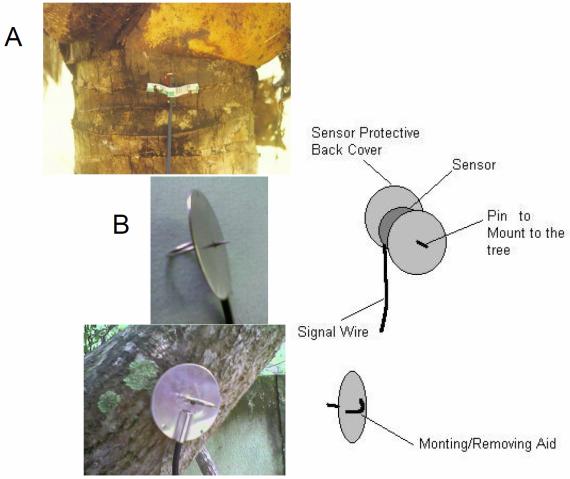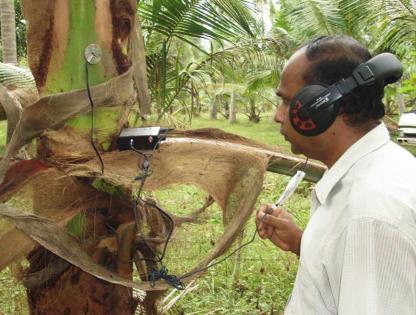Portable Electronic Red Palm Weevil (Rynchophorus Ferrugineus Olivier) Larvae Detector [RWL]
Submitting Institution
King's College LondonUnit of Assessment
Computer Science and InformaticsSummary Impact Type
TechnologicalResearch Subject Area(s)
Engineering: Electrical and Electronic Engineering
Medical and Health Sciences: Neurosciences
Summary of the impact
Research led by Dr Nanayakkara has directly enabled the development of a
new sensing device
that offers 97% accuracy in the discovery of red weevil palm infestations,
allowing early treatment
and significant financial savings for coconut producers. An estimated 10%
of the global palm
production is damaged due to a pest called the red palm weevil. In Sri
Lanka alone, contributing
approximately 2% of the World's coconut production, the annual cost of the
damage is estimated to
be around £15 million, causing both economic and social problems. Dr
Nanayakkara, in
collaboration with the Sri Lanka agricultural council, has developed a
portable electronic device
that has been demonstrated to be 97% accurate in field trials conducted by
the Coconut Research
Institute (CRI) of Sri Lanka. The CRI has recommended this device to more
than 5000 coconut
state owners in Sri Lanka as the best available red palm weevil detector.
Underpinning research
The underpinning research includes novel signal processing techniques
and, as the process of
development progressed, research into energy efficiency, materials,
ergonomics and sensor
design. Signal processing research has concentrated on the role of larval
motor primitives in action
generation and the temporal and frequency characteristics of acoustic
signals generated by the
crunching behaviour of red weevil larvae (RWL). Use is made of appropriate
signal processing
algorithms to extract signals that can be used to cue human recognition of
the auditory signals that
reveal infestation.
Role of motor primitives on action generation: In [1] it is shown
that motor primitives have
correlated tuning in position and velocity spaces, leading to
characteristic signal generation. The
motor activity of RWL is governed by a few ganglion circuits that work as
central pattern
generators, so it follows that a series of characteristic frequency bands
in the acoustic signal can
be anticipated from the crunching behaviour of RWL. The signal processing
algorithm developed
by Nanayakkara and his collaborators is optimized to
preserve the characteristic features of the rhythmic
crunching behavior of RWL, while filtering out the
noise generated by the twist of the trunk and sway of
leaves due to wind, activity of other insects, movement
of water in the tree trunk, and other background
sounds.
Novel transducer arrangement: Extensive field
experiments over six years helped in determining that
fast checking from four different places on the trunk of
the tree improves the accuracy in localizing the
infested region of a tree [2]. The precision of sensor
placement, by punching a pin attached to the
transducer into the hard bark of the tree, was found to
play an important role in this regard. After studying
human ergonomics, a sensor arrangement was designed that makes it easy for
a user to mount
the sensor on a relatively stiff coconut tree trunk using the thumb and
pull it out using the index
finger as shown in Figure 1 (A) and (B). The exact dimensions of this
arrangement are being
patented. Worse-case scenarios of applied forces were studied to design
the material and strength
of the complete sensor arrangement.
 Figure 1: The novel sensor head designed to serve the needs of
quality sensing and ergonomics of field handling.
Figure 1: The novel sensor head designed to serve the needs of
quality sensing and ergonomics of field handling.
Exploitation of the role of short term memory in human auditory signal
discrimination: The
background sounds mentioned above make it difficult to detect the weak
acoustic signal generated
by the RWL using the conventional practice of placing the ear on the trunk
of the tree. Field
experiments supported the discovery that the signal discrimination
capability of the human auditory
system improves when participants try to detect the crunching activity of
the RWL in coconut palm
trees soon after listening to a refined auditory signal of the crunching
sound of RWL. This led to
inclusion, within the device, of a pre-recorded sound clip of the
crunching sound to enhance the
detection accuracy [3].
Key Researcher at KCL
Dr. Thrishantha Nanayakkara
King's College London throughout REF period
References to the research
*[1] G. Chin-Wei Sing, W. M. Joiner, T. Nanayakkara, J. B.
Brayanov, and M. Smith, "Primitives for
motor adaptation reflect correlated neural turning to position and
velocity", Neuron, vol. 64, Issue
4, pp. 575-589, November 2009. DOI: 10.1016/j.neuron.2009.10.001
*[2] K.A.P. Siriwardena, L.C.P. Fernando, N. Nanayakkara, K. F. G.
Perera, A.D.N.T. Kumara and
T. Nanayakkara, "Portable Acoustic Device for Detection of Coconut
Palms infested by
Rynchophorus ferrugineus (Coleoptera: Curculionidae)", Journal of
Crop Protection, vol. 29, pp.
25-29, 2010 DOI: 10.1016/j.cropro.2009.09.002
*[3] J.G. Taylor, V. Cutsuridis, M. Hartley, K. Althoefer, and T.
Nanayakkara. "Observational
Learning: Basis, Experimental Results and Models, and Implications for
Robotics." Cognitive
Computation: September 2013, Volume 5, Issue 3, pp. 340-354 DOI:
10.1007/s12559-013-9208-1
Relevant Grants:
Departmental Pump-priming funds, 2012: £2000
Council for Agricultural Research Policy of Sri Lanaka (CARP) funding for
embedded sensor
design prototypes, 2005: £3253
* Publications indicating quality of underpinning research.
Details of the impact
Financial losses due to red weevil attacks are caused by two factors:
direct loss of seedlings due to
infestation, which includes the investment in nurture of the seedlings,
estimated at approximately
£10 million per annum in Sri Lanka alone, and the loss of production while
replacement trees are
established for those that are infected, taking five years to reach
production maturity. The latter
loss is estimated at £5 million per annum in Sri Lanka. Early detection of
the red weevil can
significantly reduce the lost investment in seedlings and the loss of
production, since early
chemical treatment can kill the pests. Sri Lankan production amounts to
about 2% of world
production of palm nuts.
The Coconut Research Institute of Sri Lanka (CRI) has been investigating
technologies suitable for
detection of RWL for more than a decade. However, earlier devices had
failed to achieve adequate
levels of detection accuracy and suffered from high power demands and
weight. For example, the
Davis detector and a further Sri Lankan design, both require two 9V
batteries for operation and
were too bulky for convenient portage around plantations.The CRI
approached Dr Nanayakkara to
request his help in the development of a new device.
Dr. Nanayakara proposed going beyond acoustic signal processing to a
hybrid approach
combining embedded signal processing with the human auditory signal
discrimination capacity,
based on both neuroscientific research and the biological basis of the RWL
crunching behaviour.
The development of the device progressed from laboratory
prototypes to a field trial version capable of deployment. The
final design is deployed, currently in small numbers, although
larger scale manufacture is in progress.
Weight reduction and compactness: By careful design for
efficient energy management Nanayakkara and his team
engineered a system powered by a single 9V battery. Their new
technology not only saves power, but also reduces the total
weight of the device. The current design (show in use in Figure
2) uses only 10 x 8 x 4 cm of space (a more than five-fold reduction in
volume over the first prototype).
 Figure 2: The novel detector being used in a field trial.
Figure 2: The novel detector being used in a field trial.
Higher accuracy of detection: Field-testing over the last two
years has supported better
understanding of the ideal way to use the device and the final device
detects infested palms with
an accuracy of 97% at the first observation, which can be further improved
by re-checking one
month later. It is also highly reliable (93%) in identifying true
negatives (identifying unaffected
trees). This field trial evidence has been critical in the progress from
field trial to the
recommendation for widespread use.
Design Success Recognition: In 2012, Dr Nanayakkara was
shortlisted by the Royal Academy of
Engineering for the ERA Foundation Entrepreneurs Award in recognition of
the significance and
design achievements in the construction of the detector [B].
Deployment: Once a quality assurance report was obtained from the
Coconut Research Institute
of Sri Lanka, 25 devices were manufactured and sold to farmers. It was
found from the feedback
from the farmers that in addition to the high reliability of detecting
infested palms, the use of the
device provides many advantages:
a. Detection of early stage of infestation, even when external symptoms
are not visible.
b. No cleaning of palms is required before use, which saves the cost of
labour compared to
the checking of palms by the previously recommended method.
c. A very short time of about 1 - 3 min is required to check each palm.
d. The device can be used to check whether chemical treatment applied on
palms is effective.
e. User-friendliness in mounting of the sensor on the palm and clear
output of crunching
sound make the device convenient and practical to use.
The farmers are overwhelmingly positive about the use of the device.
The Coconut Research Institute director confirms [A]: "25 units have
already been distributed
among the farmers at cost and there is an overwhelming demand to produce
more. We have
commissioned an initial production run of 50 units while we tender for
large scale manufacture of
the device." and "In recognition of Dr Thrishantha Nanayakkara's
significant role in the R&D phase,
the CRI has included him in the patent application that has been filed."
He also observes [A]: "The Coconut Research Institute considers this
Red Palm Weevil detector to
be the best tool to aid coconut estate owners to detect the Red Weevil
Larvae in palms at the early
stage of infestation, allowing them to treat the pest as early as
possible. We have therefore
recommended it to the coconut estate owners in Sri Lanka."
Sources to corroborate the impact
The following documents corroborate the quoted elements above and their
authors can
corroborate claims for production numbers, deployment and use of the
device, as well as the role
of KCL research in the development of the detector.
[A] Letter of support and report on manufacturing orders from the
Coconut Research Institute, Sri
Lanka.
[B] Letter confirming shortlisting for Royal Academy of
Engineering ERA Foundation
Entrepreneurs Award, 2012.